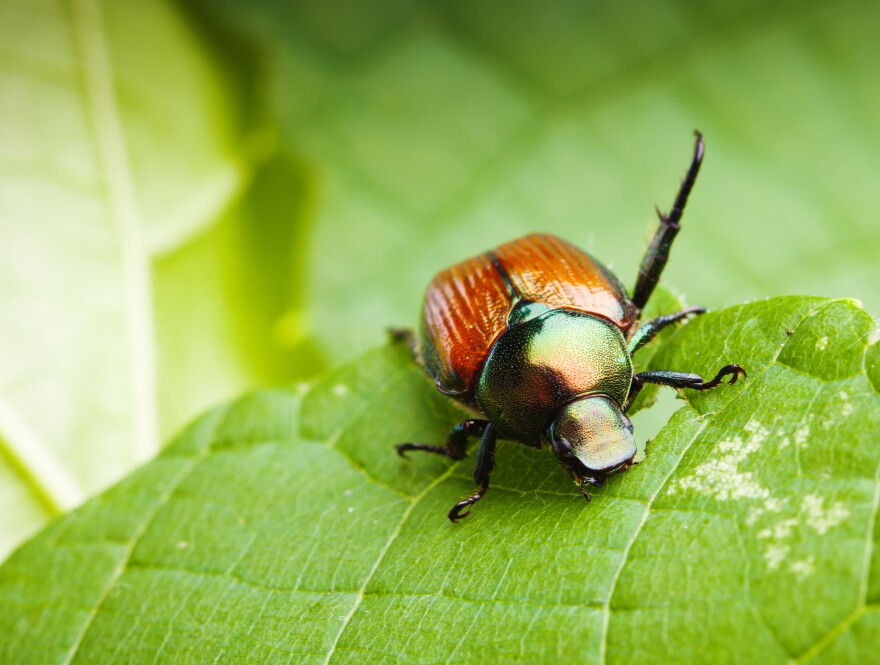The adult Japanese beetles are out. They're hungry and they're not picky eaters! This insect will munch on more than 300 different plants in your garden and flower bed. So before you lose a good chunk of your produce and posies, you can do a bit of work to control them by knowing how and when it's most effective to do so.
These beetles are known for their broad appetite. They will eat most anything – from basil, to zinnias, to grapes and raspberries and their favorite: roses!
More from All Things Gardening: Squash Those Squash Bugs! (And Mash Those Potato Beetles)
To get ahead of a small infestation in your garden
Go out to your garden each morning armed with a bowl of soapy water, then just flick them in. They will perish quickly and you'll get ahead of them before they can mate and lay more eggs.
To take care of a bigger infestation
This method uses a product called kaolin clay. Using this product creates a dusty environment on your plants' and veggies' leaves. The beetles do not like it and won't lay eggs there.
Another method is to trap the beetles. Proper placement of traps is the key to success, though! Keep traps a couple hundred feet from your garden and use a couple of different traps around the perimeter to help reduce the population.
Beetle prevention using the insects' life-cycle
At this point in the growing season, Japanese beetles are mating and laying eggs in the grassy areas in soil, close to where they are feeding. Soon, those eggs will hatch into C-shaped grubs. This is when you can enlist the power of beneficial nematodes. This treatment comes in the form of a sponge, inoculated with the nematodes. You soak the sponge in a bucket of water, attach to a spray hose and really wet and water the areas where the beetles are known to lay eggs. The nematodes will engage in a seek-and-destroy mission by parasitizing the grubs. You can do this treatment in September or in June or both! Whichever method you choose will require a stick-to-it attitude, so the beetles don't get out of hand.
Q: I've harvested all of our spring pea crop and I'm wondering if I should let the plants stay in the bed until I plant a fall crop of peas or if I should pull them out now. Will they 'fix' nitrogen over the coming weeks and therefore better to leave them in place? And what is the ideal time for me to sow seeds for a second crop of peas? - Andrea, in Cornwall
This is a good time to practice a method called, "chop-and-drop." Simply chop the foliage and leaves with hand trimmer but leave the roots in the ground. Let it drop to the ground and it will act as a mulch and fertilizer. Then, come August 1st, plant another round of peas. Try snow peas (the flat-podded ones) or snap peas, because even if they don't fill out and mature before the first frost hits, the pods are edible and delicious!
More from All Things Gardening: The Papery-Petaled Poppy, And How To Grow Many Varieties
Q: Last year I had beautiful tomato plants (cherry, roma and slicing) covered with tomatoes, but none of them ripened! We had an early frost. I covered them with sheets and had no obvious damage, but they just sat there. When I brought them inside, they did not turn red. Any suggestions for this year. I am planning on cutting off any blossoms that haven't set fruit by mid-August or earlier. Do you think that will help? - Mary Jane, in East Haven
By mid-August, start snipping off the blossoms, young fruit and growth tips on your various tomato plants. You might be using longer-maturing varieties, which is slowing things down, plus it could be that your soil is too heavy and rich in nitrogen. Try cutting back on fertilizing the soil that you're doing for next year, and also try an early-maturing variety and see if that goes better!
More from All Things Gardening: Kohlrabi Is King Of The Brassicas (And Easy To Grow)

All Things Gardening is powered by you, the listener! Send your gardening questions and conundrums and Charlie may answer them in upcoming episodes. You can also leave a voicemail with your gardening question by calling VPR at (802) 655-9451.
Hear All Things Gardening during Weekend Edition Sunday with VPR host Mary Engisch, Sunday mornings at 9:35.
Have questions, comments or tips? Send us a message or get in touch by tweeting us @vprnet.
We've closed our comments. Read about ways to get in touch here.




